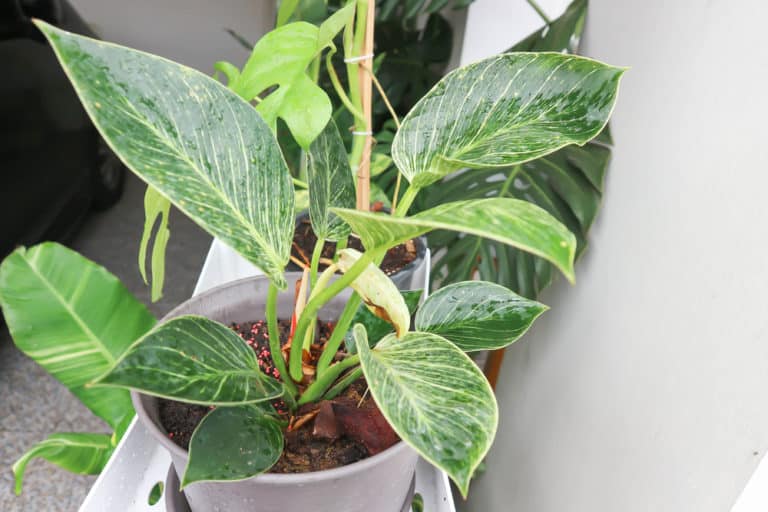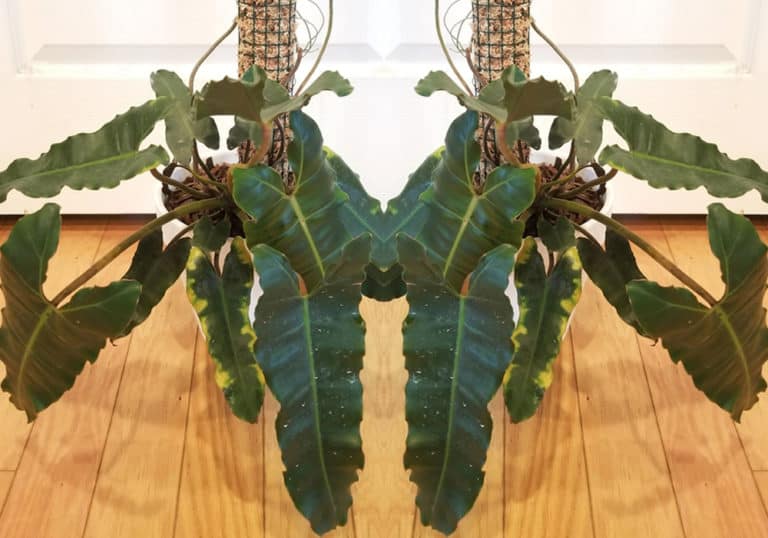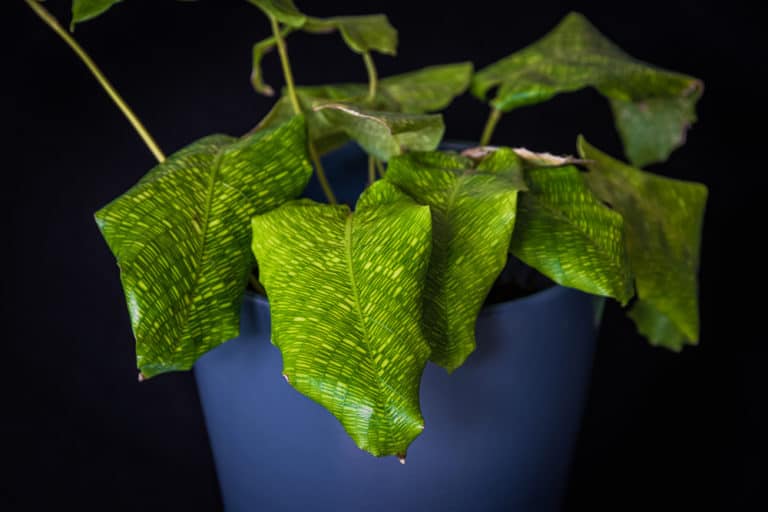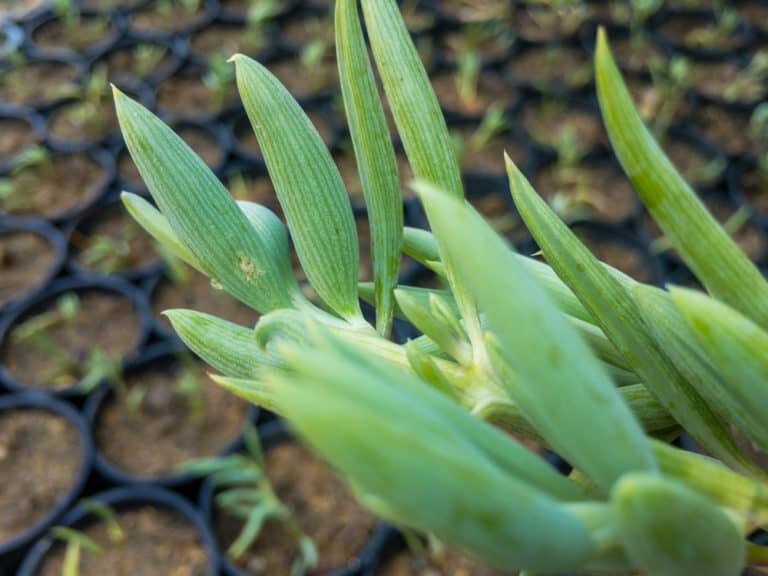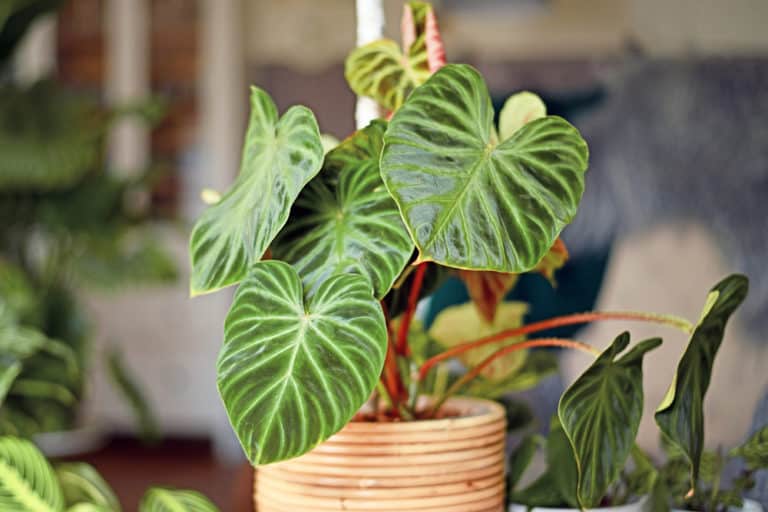Cupid Peperomia ‘Variegata’ Care Guide (2024)

Cupid Peperomia is probably one of the easiest house plants to grow, and its attractive variegated foliage is an added bonus.
Peperomia scandens variegata is also called Radiator Plant and False Philodendron. Native to the rainforests from Mexico to the tropical regions of South America, it has happily adapted to life indoors.
| Scientific Name | Peperomia scandens “Variegata” |
| Common Name | Cupid Peperomia, Radiator Plant, False Philodendron |
| Light | Bright indirect sunlight |
| Watering | Water when the soil has almost dried out |
| Temperature | 60 to 80ºF (15 to 27ºC) |
| Hardiness Zone | 10 to 12 |
| Humidity | 40 to 60% |
| Soil Type | Porous, quick-draining |
| Soil pH | 6 to 7 (mildly acidic to neutral) |
| Fertilizing | A balanced feed once a month in spring and summer |
| Repotting | Every 3 to 5 years |
| Pruning | Beginning of the growing season |
| Propagation | Root in water or soil |
| Toxicity | Not toxic to humans and pets |
| Mature Size | 3-4 feet long as a houseplant |
| Bloom Time | Rarely blooms indoors |
What’s Unique About Cupid Peperomia?
In the rainforests where Cupid Peperomia plant originates, these enthusiastic climbers trail from the branches of the towering trees. In your home, they will be just as happy in a hanging basket or on a high shelf.
Cupid Peperomia plants are prized by growers for their beautifully variegated foliage. The heart-shaped leaves are light green with a pale yellow border.
Growing Cupid Peperomia couldn’t be easier for even the least experienced plant parent. They actually prefer infrequent watering and benign neglect.
Even better, unlike so many tropical plants, Cupid Peperomia are completely non-toxic to humans and pets, making them a safe choice anywhere.
Cupid Peperomia Care
Cupid Peperomia plant care is not difficult if you can give it conditions similar to the rainforests it is native to.
For good Peperomia scandens variegata care, keep your Cupid Peperomia in bright, indirect light, and water it infrequently. Aside from the occasional fertilizing and pruning, there’s not much more than that to worry about.
Light
In tropical rainforests of Central and South America, Cupid Peperomia plants grow through the branches of the trees, living in their dappled shade.
As a result, in your home Cupid Peperomia light requirements are for bright but indirect light, or between 10,000 to 20,000 lux.
Peperomia scandens variegata light needs can be best met in a north or east-facing window which doesn’t get the full sun in the afternoon.
In a room with a south or west exposure, find a spot out of the direct sun.
In a room with no windows, such as a bathroom or office, the artificial room light may be enough for your Cupid Peperomia. However, you may need to move it to a brighter room from time to time.
Watering
Cupid Peperomia has very undemanding watering needs. In the rainforest, it survives on very little soil moisture. Their leaves and stems retain water to take it through dry periods.
In your home you will need to water Peperomia scandens variegata only when the soil is almost dried out. Otherwise, the roots will rot as they are deprived of the air they need.
Cupid Peperomia watering should be done by soaking the whole pot in a pail of water until saturated. If you try just watering the surface, the water will run right through the dry soil.
Let all the excess water drain out.
If you use tap water, let it sit overnight to dissipate all the chemicals such as chlorine and fluoride.
Temperature
The best temperature for Peperomia scandens variegata is on the warm side, since it evolved in the tropical rainforest.
The ideal Cupid Peperomia temperature range is 60 to 80ºF (15 to 27ºC). Most homes and offices can easily accommodate temperatures up to the low 70s, so supplementary heating shouldn’t be necessary.
Your biggest concern should be temperatures below that range, as Cupid Peperomia has limited
temperature tolerance below 50ºF (10ºC). You even need to be careful to keep it out of the way of drafts or air conditioning vents.
It should be no surprise that this tropical native has no frost hardiness at all, and will be killed by freezing temperatures.
Humidity
Cupid Peperomia humidity requirements are not terribly exacting.
While the ideal humidity for Peperomia scandens variegata is 60% or more, it will usually grow quite happily with a humidity level as low as 40%.
In many cases, you will not need to do anything to create more humidity for your Cupid Peperomia.
However, if the edges of the leaves start to crisp up a bit, you should give it some help.
You can use a fine sprayer to mist the foliage every few days, using distilled water.
If you have several tropical plants grouped together, setting a small humidifier in their midst will be good for all of them.
Soil
It is absolutely essential that your Cupid Peperomia soil is porous and loose, letting water drain out and air get to the roots.
The best pH level for Peperomia scandens variegata is 6 to 7 (mildly acidic to neutral).
You don’t need to buy specialty soil for Peperomia scandens variegata. In fact, your soil mix doesn’t need to contain any actual soil at all.
Just mix together equal parts of peat moss and perlite.
The peat moss will keep the mix loose and help keep it slightly acidic. The perlite will further open it up and hold enough moisture without getting waterlogged.
Fertilizer
Cupid Peperomia does not need heavy doses of fertilizer, but its foliage will be at its best with some feeding.
Use a fertilizer for Peperomia scandens variegata with a balanced fertilizer ratio of 10-10-10.
The best options for Cupid Peperomia fertilizer are a liquid formulation or slow-release granules.
If you use the granules, you will only need to add them to the soil a few times a year.
If you prefer to use a liquid fertilizer such as fish emulsion, apply it to the soil surface just after you have watered the soil. If you try to fertilize it when the soil is dry, it will run straight through without being absorbed.
Potting & Repotting
Cupid Peperomia repotting may only need to be done every 3 to 5 years, as it does not mind living in tight quarters.
However, it’s time for repotting Peperomia scandens variegata when the roots have completely filled the pot and are coming out the drainage holes.
When choosing a new container, only go up one pot size, or two inches across at most. An unglazed clay pot will help keep the soil drier. Make sure it’s got a good drainage hole.
Always use fresh potting soil to give your Cupid Peperomia a fresh start in its new home, and water it well to settle it in.
Pruning
The best time for Cupid Peperomia pruning is in early spring just as it’s emerging from its winter dormancy.
However, whenever you see yellowing or dead leaves, trim them off, no matter the time of year. They detract from the appearance and may harbor disease.
In spring, prune out any straggling stems that don’t look the way you like. It’s really just a matter of shaping your Cupid Peperomia to suit your tastes.
When cutting Peperomia scandens variegata, use sharp, sterilized scissors and cut just above (or below, for a trailing stem) a node. This will stimulate new, bushier growth.
Propagation
Cupid Peperomia propagation is best done by rooting stem cuttings, as this ensures that your new plants will have the same variegated leaves as their mother.
To propagate Peperomia scandens variegata, cut healthy stems with at least two sets of leaves. Cut so that there is a node close to the bottom of your cutting.
Put the stems in a jar of water or in a moist soil mix.
Keep the cuttings in humid air by placing a plastic bag loosely over them. If they’re in water, change it every few days.
Within a month, your cuttings should have grown roots, and can be planted out in their own pots.
Common Problems of Cupid Peperomia
If you don’t want any Cupid Peperomia problems, treat it just the way it likes.
Most problems with Peperomia scandens variegata are caused by imperfect growing conditions.
The leaves of your Cupid Peperomia are a good early warning system. When they show signs of disease or damage, deal with the problem as soon as possible.
Pests
Peperomia scandens variegata can be attacked by common indoor plant bugs.
Use insecticidal soap or neem oil spray as a preventative measure to keep Cupid Peperomia pests away.
However, even if they turn up, it’s usually not too difficult to get rid of them.
Spider mites leave sticky webs behind, as well as yellow or white spots on the tops of the leaves. A good spraying with a handheld shower or sink nozzle will clean them off.
Mealybugs look like tiny puffs of cotton on the underside of leaves. Wipe them off with a cotton ball soaked in rubbing alcohol.
Fungus gnats are tiny black flies found on the soil surface. Keep the top of the soil dry at all times to discourage them.
Diseases
Cupid Peperomia diseases are usually the result of overwatering, which can foster the growth of fungus and bacteria.
Pythium root rot is probably the most common disease affecting Peperomia scandens variegata.
If the leaves of your Cupid Peperomia have turned yellow, and the stems are getting soft, check the roots by pulling the plant out of its pot.
If some of them are black, you have root rot. Cut away all affected tissues, and replant in fresh soil mix after disinfecting the pot.
In future, you must only water your Cupid Peperomia when the soil is almost completely dried out.
Growing Problems
Usually, giving yourself a quick refresher on Cupid Peperomia’s preferred growing conditions will help you identify the cause of growing problems. Then, all you have to do is improve its situation to cure your sick plant.
If the leaves of your Cupid Peperomia are turning first yellow and then brown, you are giving it too much light. Move it to a shadier spot.
If the leaves are curling as they turn yellow, you’re giving it too much water.
If the stems are long and straggly, with leaves few and far between, it’s not getting enough light. Move it to a brighter location.
Toxicity of Cupid Peperomia
Peperomia scandens variegata is not toxic to humans or any other animals.
This lack of toxicity makes it a perfect choice for homes with children and or pets, or both.
However, even non-toxic plants can cause digestive problems, so it’s best to exercise some caution when using them in the home.
For Humans
Cupid Peperomia is not at all toxic to humans. If you have children in your home, you may feel much more comfortable growing this plant rather than a member of the araceae or rubber tree families.
However, you should still keep your Cupid Peperomia out of reach of little hands and mouths.
You may be using insecticidal sprays to control bugs on your plants, which children should not be exposed to.
As well, the foliage may be difficult to digest, leading to intestinal upsets. They won’t require a trip to the hospital, but still can be very unpleasant, both for the child and you.
For Pets
Cupid Peperomia is not at all toxic to your pets, so you can add it to your indoor garden without any concerns.
However, if a cat or dog eats too much of the foliage, their carnivorous digestive systems will have difficulty dealing with it. The result may be vomiting and diarrhea. It won’t be life-threatening, though.
As well, a determined cat can inflict a fair amount of damage on a houseplant, which of course you would like to avoid.
Keeping Cupid Peperomia plants in hanging baskets or on a shelf far from the floor will eliminate any of these risks.
Cupid Peperomia Appearance
The Cupid Peperomia appearance is defined by its profusion of light green and cream heart-shaped leaves which grow on long, trailing stems.
Its unremarkable flowers rarely appear, but that’s not a problem when the foliage is so lovely.
The fresh appearance of its colorful leaves make it a natural fit in a variety of settings.
Foliage
The foliage of Cupid Peperomia is without a doubt its main attraction for growers.
Each heart-shaped leaf is a fresh, light green surrounded by a creamy white border. Leaves grow to about 2 inches long.
While Cupid Peperomia is not a succulent, its glossy leaves are thick and leathery, and hold moisture.
The petioles are a pale pink, adding more color interest to this tropical plant.
Since Cupid Peperomia is a tropical evergreen, the leaves remain on the stems for a long time. To avoid a build-up of dust or grime, you should clean them regularly by wiping them down or giving the plant a refreshing shower.
Flowering
While Cupid Peperomia flowering is possible, blooming rarely occurs on a plant grown in a pot indoors.
When a Cupid Peperomia can be grown outdoors planted in the ground in a tropical region, it is more likely to bloom.
The flowers are small and unremarkable light green spikes, with no fragrance.
If you do see flowers developing, you may choose to cut them out to let your Cupid Peperomia concentrate its energies on growing its foliage.
The lack of flowers does not detract from the overall desirability of Cupid Peperomia, since its lush, variegated leaves are the reason for growing it.
Size and Growth
The mature size of Cupid Peperomia grown indoors as a potted plant is about a foot tall, with trailing stems growing up to 4 feet long. It will not grow much wider than about a foot across.
Its growth rate is moderate to fast, taking 2 to 5 years to reach its full size.
It is a naturally trailing plant, so the best way to grow it is in a hanging planter or on a pot placed high enough to let its stems hang down.
Cupid Peperomia can be planted in the ground in tropical regions with warm temperatures year-round.
Cupid Peperomia Fragrance
There is no Cupid Peperomia fragrance.
The rare Peperomia scandens variegata flower has no scent, and the evergreen foliage is likewise fragrance-free.
If you have a sensitivity to heavy fragrances, you can use Cupid Peperomia in your home without worrying about adverse reactions.
Equally, places like nursing homes and medical offices often ban scented plants for that same reason. This low-maintenance and fragrance-free plant is ideal for use in those settings.
Combining Cupid Peperomia with other plants that do have a pleasant fragrance can give you the best of both worlds in your indoor garden: beautiful foliage and scent.
Suggested Uses for Cupid Peperomia
Because Cupid Peperomia is such a low-maintenance plant, it’s a natural choice for settings where some benign neglect may occur.
In an office or other indoor public space, a Cupid Peperomia will require little more than occasional watering and fertilizing.
At the same time, the fresh appearance of its leaves and trailing stems will add a touch of tropical nature in even the most workaday space.
Hanging a Cupid Peperomia outdoors in summer can instantly fill in a bare patio or deck and help create a tropical oasis.
In a small studio apartment, this trailing beauty takes up no valuable floor space.
FAQ
What is Cupid Peperomia?
Cupid Peperomia is a trailing vine, native to the tropical rainforests of Central and South America. It is commonly grown as a houseplant for its foliage.
How to identify Cupid Peperomia?
Cupid Peperomia has 2 inch heart-shaped leaves that are light green with creamy white margins. They are thick and leathery and grow on long trailing stems.
How to care for Cupid Peperomia?
Cupid Peperomia should be kept in bright, indirect light in warm temperatures with moderate to high humidity. Water infrequently and fertilize in spring and summer.
How to grow Cupid Peperomia indoors?
Cupid Peperomia is usually grown in a hanging planter, kept out of the full sun and away from drafts. It needs watering only when the soil is dry.
How to grow Cupid Peperomia outdoors?
Cupid Peperomia can be grown outdoors in tropical regions where temperatures stay well above freezing year-round. Allow it to climb supports such as tree trunks.
How fast does Cupid Peperomia grow?
Cupid Peperomia has a moderate to fast growth rate and will take 2 to 5 years to grow to its full size when grown indoors.
How tall does Cupid Peperomia grow?
Cupid Peperomia is usually grown as a trailing plant. It will grow about a foot tall but then have trailing stems to about 4 feet in length.
How to make Cupid Peperomia grow faster?
Cupid Peperomia will grow fastest when kept in bright but indirect light, warm temperatures, and high humidity, with infrequent watering and monthly fertilizing in its growing season.
How to stake Cupid Peperomia?
While Cupid Peperomia is usually grown as a trailing plant, it can also be trained up a trellis or sphagnum pole to climb upwards instead.
How to pot Cupid Peperomia?
Cupid Peperomia should be potted in an unglazed clay pot with drainage holes, in a very porous and well-draining soil mix of perlite and peat moss.
How to revive Cupid Peperomia?
If the Cupid Peperomia soil is completely dried out and the foliage is limp, immerse the pot in water until the soil is completely moistened.
Why is my Cupid Peperomia dying?
Your Cupid Peperomia may have a fungal or bacterial disease as a result of overwatering. Remove the roots from the soil and cut off all infected parts before repotting in fresh soil.
Why is my Cupid Peperomia drooping?
Your Cupid Peperomia may be in too dry or too wet soil. Either give it a good soaking or repot the plant in fresh, porous soil mix that will not retain too much water.
How cold can Cupid Peperomia tolerate?
Your Cupid Peperomia will not grow well in temperatures any lower than 50ºF (10ºC), and freezing temperatures will kill it. Keep it out of drafts.
How to get rid of pests on Cupid Peperomia?
Cupid Peperomia pests can usually be controlled with preventative sprays such as insecticidal soap or neem oil. They can be removed with a strong spray of water or wiping with rubbing alcohol.
Is Cupid Peperomia toxic to cats?
No, Cupid Peperomia is not toxic to cats at all. They can, however, develop minor digestive upsets from eating too much of the plant’s foliage.
Is Cupid Peperomia toxic to dogs?
No, Cupid Peperomia is not toxic to dogs. While dogs may develop vomiting and diarrhea if they eat too much of the leaves, it will not require veterinary care.
Is Cupid Peperomia toxic to children?
No, Cupid Peperomia is not toxic to children. However, insecticidal sprays used on the foliage can be a problem, so it is best to keep plants out of their reach.
Is Cupid Peperomia toxic to humans?
No, Cupid Peperomia is not toxic to humans. While the foliage is not considered edible, there are no toxic substances or irritants in the tissue or sap.
Does Cupid Peperomia have a scent?
No, Cupid Peperomia does not have a scent. Neither the foliage nor the rare flowers have any scent at all, making it suitable for use where fragrances are an issue.


